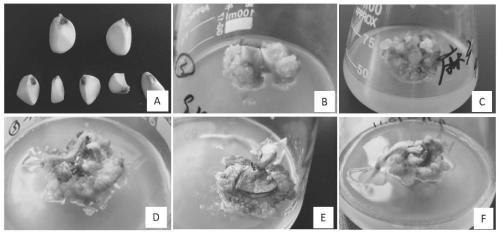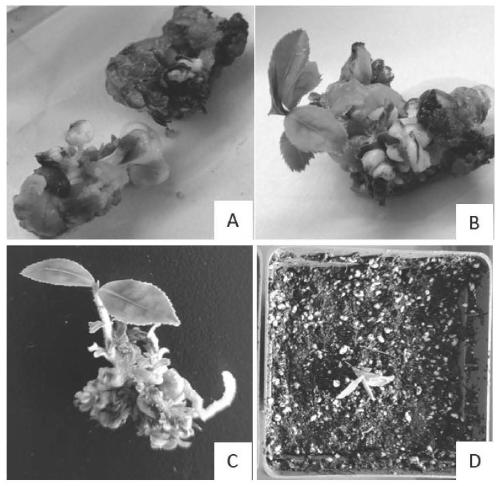Method for obtaining regenerated plants from common camellia oleifera in somatic embryogenesis mode
A technology of embryogenesis and regeneration of plants, applied in the field of plant cell engineering, can solve the problems of low plant regeneration efficiency, self-sufficiency rate of less than 40%, affecting grain and oil safety, etc., and achieve the effect of more normal regeneration plants, good social and economic benefits
- Summary
- Abstract
- Description
- Claims
- Application Information
AI Technical Summary
Problems solved by technology
Method used
Image
Examples
Embodiment
[0035] The experimental steps are as follows:
[0036] In mid-July, high-quality individual tea fruit was selected from the mature Camellia oleifera forest in Meihuashan Village, Shunhe Town, Macheng, Hubei, and stored in a refrigerator at 4°C. The disinfection and inoculation was completed within 3 days.
[0037] Under the aseptic condition of the ultra-clean workbench, peel off the camellia oleifera fruit peel with bare hands, disinfect the surface in 75% alcohol for 2 minutes, then disinfect with 0.1% HgCl for 10 minutes, rinse with sterile water 4 times, and peel off the inner skin. seed coat. Cut the immature embryos into pieces under aseptic conditions, each immature embryo was cut into 3-5 pieces, inoculated in 90mm culture dish (callus induction medium), and each dish was inoculated with 7-9 explants.
[0038] The culture medium (callus induction medium) used for inducing callus is the improved MSB medium adding phytohormone composition, and the MSB medium consists of...
PUM
 Login to View More
Login to View More Abstract
Description
Claims
Application Information
 Login to View More
Login to View More - R&D
- Intellectual Property
- Life Sciences
- Materials
- Tech Scout
- Unparalleled Data Quality
- Higher Quality Content
- 60% Fewer Hallucinations
Browse by: Latest US Patents, China's latest patents, Technical Efficacy Thesaurus, Application Domain, Technology Topic, Popular Technical Reports.
© 2025 PatSnap. All rights reserved.Legal|Privacy policy|Modern Slavery Act Transparency Statement|Sitemap|About US| Contact US: help@patsnap.com



